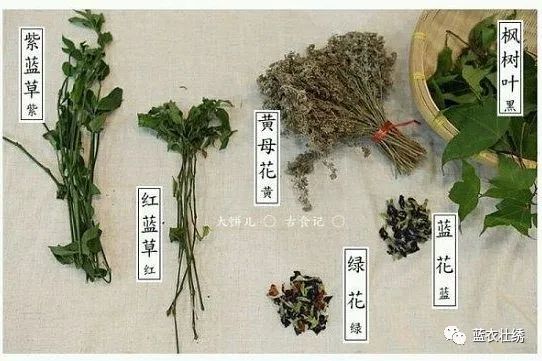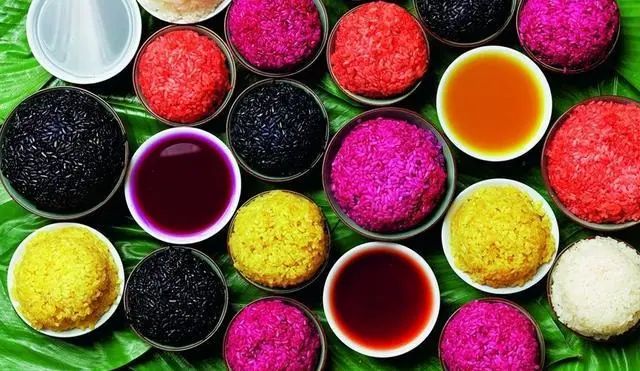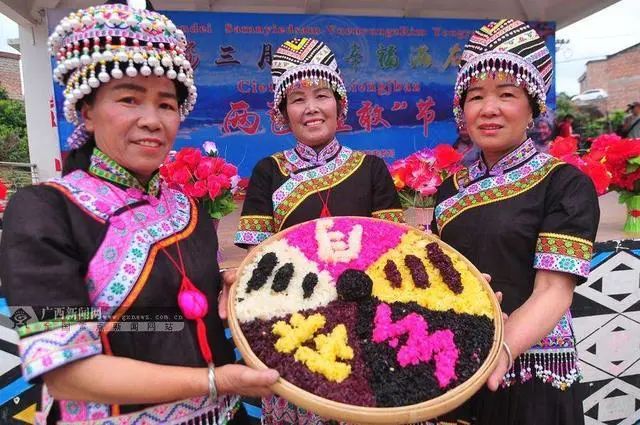广西五色糯米饭,究竟有哪五色?
色泽鲜艳、清香软糯的五色糯米饭是壮族代表性符号之一,是“壮族三月三”必不可少的传统美食,也是一种念念不忘的故乡情怀。
Nutritious and delicious, five-color (i.e. black, red, yellow, white and purple) glutinous rice is an auspicious food that symbolizes a good harvest in the eyes of the people in the Guangxi Zhuang autonomous region.

图源:IC
长期以来,由于五色糯米饭没有制定产品标准,无法办理食品生产许可证,产品加工制作也只能以家庭式、小作坊式为主,加上制作五色糯米饭的天然着色原料难以保持,以及工艺流程长等因素,五色糯米饭产业难以做大做强。
今年2月,在多方积极推动下,广西壮族自治区卫生健康委正式发布《五色糯米饭》和《红蓝草》两项广西食品安全地方标准,并将于5月1日起实施。其中,红蓝草为五色糯米饭中的红色染色剂。
根据《五色糯米饭》食品安全标准,规定了五色糯米饭的术语和定义、产品分类、要求、食品添加剂、生产加工过程的卫生要求、检验方法、检验规则、标签、标志、包装、运输、贮存和保质期。
那么五色糯米饭到底是怎么样的呢?有哪“五色”呢?
五种色彩
五色糯米饭是广西壮族自治区布依族、壮族等许多民族的传统风味小吃,因呈黑、红、黄、白、紫5种色彩而得名。每年农历三月三、清明节、四月八、端午节等民间传统节日,广西各族人民普遍制作五色糯米饭,以作赶歌圩食用,或祭祖祭神之用。
Every ethnic group in Guangxi makes the five-color glutinous rice on March 3, Qingming Festival, April 8, Dragon Boat Festival and other folk traditional festivals in the lunar calendar. It caters for people attending the Folk Song Fair, or is used as one of the sacrifices to ancestors and gods.
五色糯米饭主要采用天然植物萃取色素,属于大自然的馈赠。采来紫蓝草(紫色)、黄母花或黄栀子(黄色)、红蓝草(红色)、枫树叶(黑),浸泡出各色颜液,选好优质糯米加以浸泡10个小时,浸泡后捞出五色糯米沥干水分,自然风干15分钟,风干后的五色糯米饭显示出绚丽的色彩。

图源:蓝衣壮绣
天然植物染成
壮家人民把五色糯米饭看作吉祥如意、五谷丰登的象征。五色糯米饭五彩缤纷,鲜艳诱人,天然色素对人体有益无害,各有清香,别有风味,可谓是色、香、味俱佳。
On the one hand, it is regarded as good luck as well as a symbol of fruitful harvest of the crops of the year; on the other hand, the rice is colorful, bright and attractive with unique fragrance and flavor. It is made of natural pigment, which is good for our health. Colorful, fragrant and tasteful, how delicious it is!

图源:腾讯新闻
用天然植物染成的五色糯米饭有一定的药用价值。如用来染红颜色的“红蓝草”具有生血作用,染黄颜色的“黄母花”或“栀子”具有清热凉血等作用,而染黑颜色用的枫叶,李时珍在《本草纲目》里说:枫叶“止泄益睡,强筋益气力,久服轻身长年”,还说用枫叶煮成的青精饭,人食之能“坚筋骨、益肠胃、能行、补髓”。

图源:民族光影视觉
上榜“非遗”
壮族五色糯米饭制作技艺历史悠久,源于壮族传统农耕社会生产生活,依托武鸣“壮族三月三”等民间节庆习俗传承发展。2010年5月,壮族五色糯米饭制作技艺列入广西第三批自治区级非物质文化遗产名录。
Craftsmanship of making the five-color glutinous rice has a long history. In May 2010, the preparation of the five-color glutinous rice was inscribed on the third list of Intangible Cultural Heritages of Guangxi Zhuang autonomous region.

图源:民族光影视觉
五色糯米饭的传说
相传,有位才智超群的壮人韦达桂,在土皇帝手下为臣。一年大旱,他为解除百姓疾苦,奏邀土皇帝亲往壮乡视察,用计使皇帝免去皇粮。土皇帝后来发觉上了当,把达桂视为眼中钉,下令捉拿他归案。壮乡百姓闻知,连夜送达桂上山躲藏。皇兵捉拿不着,就放火烧山,那天正是农历三月初三。
It is said that Wei Dagui, an intelligent man of Zhuang ethnic group, was an official serving for the local despot. One year, the Zhuang Township suffered a severe drought. In order to relieve the local people of the suffering of drought, Wei reported to the despot to visit and investigate the Zhuang Township in person, aiming to make the despot to exempt people from grains committed to the court.
However, the despot later found that he had been taken into the trap so that he regarded Wei as a thorn in the flesh, and ordered that Wei wanted and arrested. People heard about it and hided Wei into the mountain overnight. The soldiers set fire to the mountain because they couldn't find Wei anyway. And that day, was the March 3 of the lunar calendar.
皇兵走后,乡亲们在一棵大枫树洞里找到达桂尸体,含泪把他葬在枫树旁,而正好皇帝被一只五种颜色的蛇咬死了。因此,以后的每年三月三,壮人把米放入枫叶等植物颜汁中浸泡,等其上色后放入蒸笼中蒸约1小时,便可蒸出红、黄、紫、黑、白(糯米本色)五种颜色的糯米饭,蒸熟后拿到山上祭祀,以此纪念达桂,也就有了五色糯米饭。
After the soldiers left, the villagers found Wei's body in a big maple hole and buried him sadly with tears near the maple. It was a coincidence that the despot was bitten to death by a five-color snake on the same day. Therefore, on March 3 every year, people soak the glutinous rice in the juice of maple leaves and other plants.
Then, it is steamed for about one hour after being dyed into the five colors of red, yellow, purple, black and white (natural color of the glutinous rice). As one of the sacrifices, they took it to the mountain to honor Wei. Since then, the five-color glutinous rice has become a kind of traditional food in Guangxi.

图源:腾讯新闻
五色糯米香饭是壮族人民寄予幸福、美好、和谐、吉祥、如意的象征,是壮族人民过着五谷丰登火红日子的写照。你吃过壮家的五色糯米饭吗?
 微信
微信




 桂公网安备 45020202000113号
桂公网安备 45020202000113号